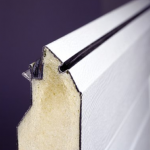If your new post frame building will only ever be cold storage, then an insulated overhead door just might be all your will ever want, or need. For most people, I encourage them to go with insulated doors, just on the oft chance someone down the line will have different ideas. Insulated overhead doors do tend to ‘feel’ stiffer and to rattle less in a strong breeze.
But what about the R-values of those doors?
 Consider this – insulated overhead doors are using polyurethane, which has an initial R-value of maybe as much as 7.5 per inch, however the R-value does decrease with age so a more realistic high end “aged” R-value would probably be closer to 6.5 per inch.
Consider this – insulated overhead doors are using polyurethane, which has an initial R-value of maybe as much as 7.5 per inch, however the R-value does decrease with age so a more realistic high end “aged” R-value would probably be closer to 6.5 per inch.
Several overhead door manufacturers report their polyurethane insulated door panels to be as much as R-9.0 per inch, which is both highly unlikely and technically impossible to achieve!
One overhead door company in Maine actually sent an overhead door with an insulated 1-3/8 inch thickness which was advertised as being R-12.76 to be independently tested. The door came back as being actually only R-7.83!
This same company now has what they call their “R-value challenge” to manufacturers. They will write a check to any manufacturer who can prove a 1-3/8 inch thick door is R-12! They have not had to pay yet, and probably never will.
To determine the true thermal performance of an insulated overhead door, one would need to know two things, the door’s ‘leakiness’ and the R-value of the entire door assembly.
 The R-values used by garage door manufacturers are measured at the center of the panels, and it appears no one is reporting the R-value of the entire assembly which would include the panel edges, seams between panels and the perimeter of the door.
The R-values used by garage door manufacturers are measured at the center of the panels, and it appears no one is reporting the R-value of the entire assembly which would include the panel edges, seams between panels and the perimeter of the door.
In comparison of manufacturer’s R-value claims with test reports of the installed doors as part of a system, it appears the R-value of a garage door installed is going to be about one-third of the value claimed in the manufacturer’s brochures!
Even if garage door manufacturers do decide to report whole door R-values, the big piece will still be missing – when it comes to thermal performance of garage doors, air leakage matters more than R-value.
Most important when looking at the thermal performance of an overhead door is a design which minimizes air leakage, with good gaskets between the panels, heavy-duty weatherstripping at the bottom of the door and weather seals up the sides and across the top of the openings.






